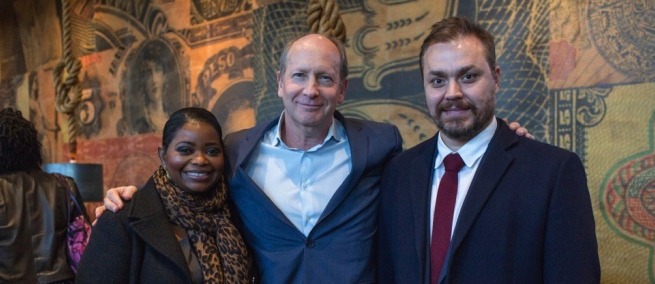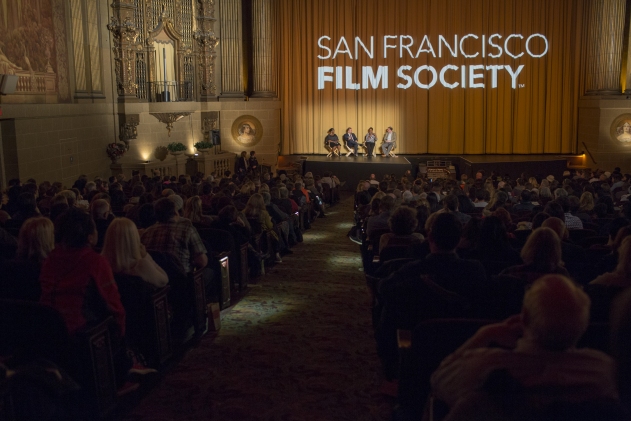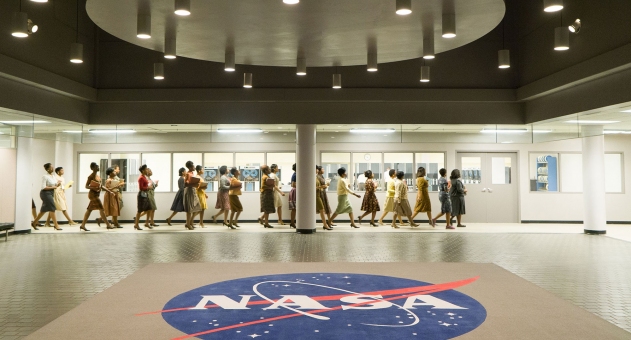
In December, Science & Film visited Vice President of Programs Doron Weber at the Alfred P. Sloan Foundation offices in Rockefeller Center. As we spoke, the annual Christmas tree towered above the plaza, and visitors to Radio City Music Hall lined up to see the Rockettes.
Weber runs the Sloan Foundation’s Public Understanding of Science & Technology program, which supports film, theater, radio, television, books, and new media. The new movie HIDDEN FIGURES is based on a book which Sloan’s book program supported in 2014, and the film was later awarded the 2016 Sloan Science in Cinema Prize by the San Francisco Film Society–an example of how the funding model works synergistically so that these stories can reach a wide public. Science & Film spoke with Weber about HIDDEN FIGURES, and what new projects the Public Understanding program is supporting.
Science & Film: So, have you seen HIDDEN FIGURES?
Doron Weber: I saw it at the Paley Center with a packed audience of African-American female high school students. The atmosphere was almost electric. I haven’t had that experience since the first STAR WARS came out and the audience got so into it, because they had never seen anything like this. This audience was so inside the movie they would applaud a character responding to another character.
The story focuses on three African-American women who are the smartest people in the room, and it takes a long time for their colleagues to understand how smart they are. I think HIDDEN FIGURES is a transformative film. The movie stars three women mathematicans and engineers but as the author Margot Lee Shetterly writes, there were many more women in these roles–she thinks there were a hundred and possibly more. For me, the great moment in Margot’s book was when she wrote that growing up in Virginia, “I thought the face of science was brown like mine.” Everyone she knew was an engineer or mathematician.
S&F: Sloan gave the film the first prize it has received. You went to San Francisco to give the prize, what was that like?
DW: It was packed. We had Black Girls Code and Hack the Hood come, and the heads of those organizations brought their daughters. It is like the young black people who grew up with Obama as President and see that as normal. Without going overboard, I think this film could have a similar kind of impact because it provides new role models that will ramify into the culture. We are exploring turning the story into a television series–that is something I would like to do and Margot is interested. There is so much richness and possibility. To live with those characters over time would be very interesting and instructive.

S&F: Why do you think this film is resonating so much now?
DW: I think it is important in this moment with what we are going through as a society. There has been some talk of racism and of going backwards. The story this film tells is undeniable because it is a matter of historical record, and it shows you how far we have come. I think it is very positive; it is about what is good about America. Everybody who is American is going to root for this story, for those characters, and in doing so will be embracing certain values that I think are really important. The film even works in terms of the Cold War. We thought that time had long gone, but now some people are saying we are in another phase of the Cold War which is even more dangerous with the possibility of it heating up with Putin and Russia. So, the film has all these resonances. Most of all, it has three amazing black women mathematicians—when did you ever see that? I think it will also get people excited about the Space Program.
S&F: The film shows gender bias as well as racial bias, right?
DW: There was enormous gender bias–there still is–but what struck me was all these women had supportive husbands. It is a kind of primer for men on how you behave with a woman who is really smart and your equal, if not your superior. It is definitely about women power. The forces holding women back are as powerful and deep as those that have to do with race. I think the film strikes a blow with both. For a generation of men as well as women, it models a different kind of behavior. I think it will resonate.

S&F: Do you think the book and film will reach different audiences?
DW: Margot’s book debuted on the bestseller list and now it has gone into paperback. This is what happened with A Beautiful Mind. Sylvia Nasar wrote a beautiful book, it did very well and got excellent reviews. It sold 70,000 copies, and then the movie came out with Russell Crowe on the cover and the book literally sold a million copies propelled by the movie. The Hidden Figures paperback features a photo of the three actresses. I am predicting it is going to now sell a million copies.
This is one of the reasons we work with different media. For anyone who loves the film, you should read the book. Margot is a meticulous researcher. Her story is richer and more nuanced. As wonderful as the film is, it is two hours and you have to simplify. In the book, there are many more stories so you get a deeper experience.
S&F: Are there any other film projects which Sloan has funded related to HIDDEN FIGURES?
DW: THE GREAT CIVILIZATIONS OF AFRICA by Henry Louis Gates is a six part series debuting on PBS in February that I think can also begin to reshape how we view Africa. Sloan was particularly interested in the geometry, trigonometry, and cosmology breakthroughs chronicled by the series. I hope people will start shifting the way we look at the history of Africa and therefore the history of African Americans. To me, they are of a piece.
Africa is one of the places we know the least about culturally; it is so rich and varied. I think this show will be a corrective in a very big way. There was a university in 800 AD in Africa–the first university in the world. And there was a flourishing of science and math in Fes, Marakesh and Timbuktu between the 12th and 17th centuries. HIDDEN FIGURES, hidden continent, hidden culture. In my view, science and technology are a big part of culture.
S&F: What other projects would you like to see developed?
DW: Sloan has supported many other stories about women scientists. There is a documentary about Hedy Lamarr. We have several scripts about Rosalind Franklin–PHOTOGRAPH 51 [a play by Anna Ziegler being adapted for film] is going to come to Broadway in 2017. There is a script being developed about Jane Goodall. The Marie Curie story, A NOBLE AFFAIR, is shooting in the spring of 2017. Through the San Francisco Film Society we gave Michael Almereyda a grant for a Tesla film, so I am hoping he is going to pull off the first feature film about Nikola Tesla. At Sundance, we are developing an Alexander Graham Bell story told from the point of the view of three key women in his life. He was a brilliant inventor but he also did some horrible things with eugenics. Through the American Experience, we are hoping to support a two-hour series on the history of eugenics; the historian Dan Kevles will be an advisor and Siddhartha Mukherjee, who wrote The Gene, will talk about what the role of genetics. During that period there was economic dislocation from industrialization and fear of foreigners–it reads like what is going on today. It is worth paying attention to history here.
At the Ensemble Studio Theatre, we are working on a play called SPILL. The writer Leigh Fondakowski went to the town where many of the victims from Deepwater Horizon lived and talked to the people of southern Louisiana. It is an amazing story and has become more resonant after the election because it is about the lives of working people we don’t normally see portrayed. We have another play about the conflict between traditional education and new technology–it is a terrific subject.

S&F: Have you thought about expanding the Public Understanding program to fund other kinds of media?
DW: We are judiciously dabbling. We made our first gaming grant at NYU. We are very pleased because it is a new approach. We know games are popular but the question is, can you make a game that engages with science or technology in a meaningful way? The short answer is, we don’t know. But we think you can, so we picked a project which has to do with Mendelian genetics and that seems like an appropriate area to advance understanding.
We have supported our first VR project. June Cohen is creating it with Chris Milk and Aaron Koblin’s company [Within]. It will be in a documentary series of VR projects called The Possible which General Electric is underwriting. The episode we are helping with is about LIGO and the discovery of gravitation waves. We thought VR technology could get people a little closer to what it means to observe a tiny ripple in space-time from 1.2 billion years ago and the remarkable instrumentation with which scientists pick up these little ripples and separate them from the background of vibrations on earth.
We have a new NOVA grant just approved as a sequel to HUNTING THE ELEMENTS. It includes a 3-5 minute immersive VR piece about one molecule which changed the world. If you can use VR to enhance someone’s understanding of something rather than just as a 3-D effect, it will prove useful to us.
S&F: Are there any books you would like to see adapted for the screen?
DW: We have one about physicist Richard Garwin coming out. Obama just awarded him the Presidential Medal of Freedom. He was involved in the hydrogen bomb, he has been an advisor to every president since, and he is part of JASON which is an elite group of scientists who advise the government on sensitive Science and Technology issues. He is still boyish in his 80s. The subtitle of the book, which is by Joel Shurkin, is: The Most Influential Scientist You’ve Never Heard Of. It is coming out in February.
The Pope of Physics by Gino Segre and Bettina Hoerlin is about Enrico Fermi, the most famous Italian scientist since Galileo, which would make an astonishing film. That is a drama set in World War II; it is about Fermi’s role in the atomic bomb. His wife was Jewish. He helped set up the big labs which are part of the Department of Energy. People don’t understand that the Department of Energy is responsible for nuclear weapons. Nuclear weapons need to be taken very good care of and we spend billions of dollars on that. I think the Fermi story is a fantastic story.
Doron Weber is the Vice President of Programs at the Alfred P. Sloan Foundation and Director of the Public Understanding of Science & Technology Program and the Universal Access to Knowledge Program as well as a new initiative in International Science Engagement. He has spearheaded the expansion of Sloan’s funding purview to a range of the arts over the past twenty years. Weber is author of Immortal Bird: A Family Memoir, and chair of the Writer’s Room.
Stay tuned to Science & Film for more on how the film projects covered in this interview progress.
TOPICS